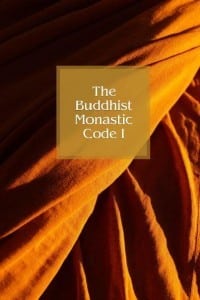 The Buddhist Monastic Code I and II is an impressive work both in virtue and extent. On nearly 2.000 pages the rules of monks in the Theravada traditions are outlined. This book is written both for the ones seeking monastic life and the bhikkus who have devoted their life to it. It will also benefit other people who have dealings with the bhikkus—so that they will be able to find gathered in one location as much essential information as possible on just what the rules do and do not entail. Students of Early Buddhism, Theravādin history, or contemporary Theravādin issues should also find this book interesting, as should anyone who is serious about the practice of the Dhamma and wants to see how the Buddha worked out the ramifications of Dhamma practice in daily life.
The Buddhist Monastic Code I and II is an impressive work both in virtue and extent. On nearly 2.000 pages the rules of monks in the Theravada traditions are outlined. This book is written both for the ones seeking monastic life and the bhikkus who have devoted their life to it. It will also benefit other people who have dealings with the bhikkus—so that they will be able to find gathered in one location as much essential information as possible on just what the rules do and do not entail. Students of Early Buddhism, Theravādin history, or contemporary Theravādin issues should also find this book interesting, as should anyone who is serious about the practice of the Dhamma and wants to see how the Buddha worked out the ramifications of Dhamma practice in daily life.
Download The Buddhist Monastic Code here:
 The Buddhist Monastic Code I
The Buddhist Monastic Code I
 The Buddhist Monastic Code II
The Buddhist Monastic Code II
The Buddhist Monastic Code in Theravada Traditions
The Buddhist Monastic Code holds immense significance in the Theravada traditions, governing the ethical conduct and discipline of Buddhist monastics. Also known as the Vinaya, this code provides guidelines for both individual behavior and the collective functioning of monastic communities. In this article, we delve into the intricacies of the Buddhist Monastic Code, exploring its historical background, key principles, and its impact on the lives of Theravada Buddhist monks and nuns.
The Buddhist Monastic Code traces its origins back to the time of the historical Buddha, Siddhartha Gautama. Recognizing the need for a set of rules to maintain harmony and integrity within the monastic sangha, the Buddha established the Vinaya as a cornerstone of monastic life. Over the centuries, this code has been meticulously preserved, interpreted, and expanded upon by learned monks and scholars, resulting in its diverse manifestations across Theravada Buddhist traditions.
Purpose and Principles
The primary purpose of the Buddhist Monastic Code is to guide monastics on the path to spiritual development and liberation. It sets forth rules and regulations that govern every aspect of monastic life, from the most mundane to the most profound. The code emphasizes the cultivation of virtues such as discipline, morality, mindfulness, and wisdom. By adhering to these principles, monastics aim to purify their minds, transcend worldly attachments, and attain enlightenment.
Structure and Content
The Vinaya is structured in a systematic and hierarchical manner. It comprises various sections, or “khandhakas,” each addressing specific aspects of monastic life. These include rules pertaining to proper conduct, daily routines, proper use of requisites, interactions with the lay community, and guidelines for monastic ceremonies. The code also encompasses guidelines for resolving disputes, conducting disciplinary proceedings, and the role of senior monastics in maintaining harmony and order within the sangha.
Adherence and Benefits
Theravada monastics view the observance of the Buddhist Monastic Code as crucial for personal and communal development. By strictly adhering to the code, monastics demonstrate their commitment to ethical conduct, renunciation, and the pursuit of liberation. This adherence fosters a sense of harmony, respect, and trust within the monastic community, providing a conducive environment for meditation, study, and spiritual growth. Moreover, it establishes a foundation of moral integrity that garners respect and support from the lay community.
Challenges and Interpretation
The interpretation and application of the Buddhist Monastic Code pose challenges due to the diverse cultural contexts and modern-day complexities. While the essence of the code remains intact, some rules may require contextual adaptation to align with the needs of contemporary monastic life. This ongoing process of interpretation calls for the wisdom and discernment of monastic elders and scholars to ensure the preservation of the code’s spirit while addressing the evolving needs of the sangha.
The Buddhist Monastic Code plays a vital role in shaping the lives of Theravada Buddhist monastics. It provides a comprehensive framework for ethical conduct, discipline, and communal harmony within the monastic community. By observing this code, monastics uphold the principles laid down by the Buddha and maintain a strong foundation for spiritual development. As the Theravada traditions continue to thrive and evolve, the Vinaya remains an invaluable guide for monastics seeking enlightenment and the realization of the Buddhist path.

